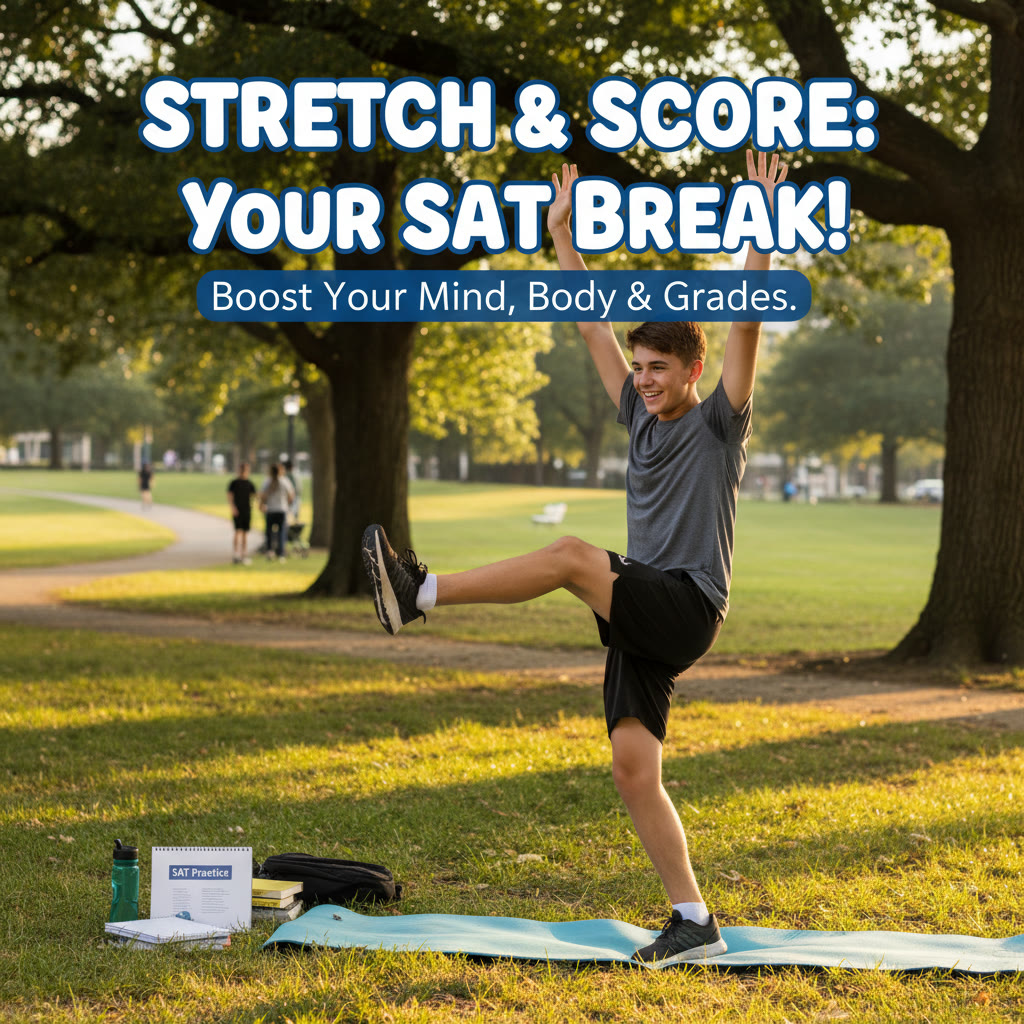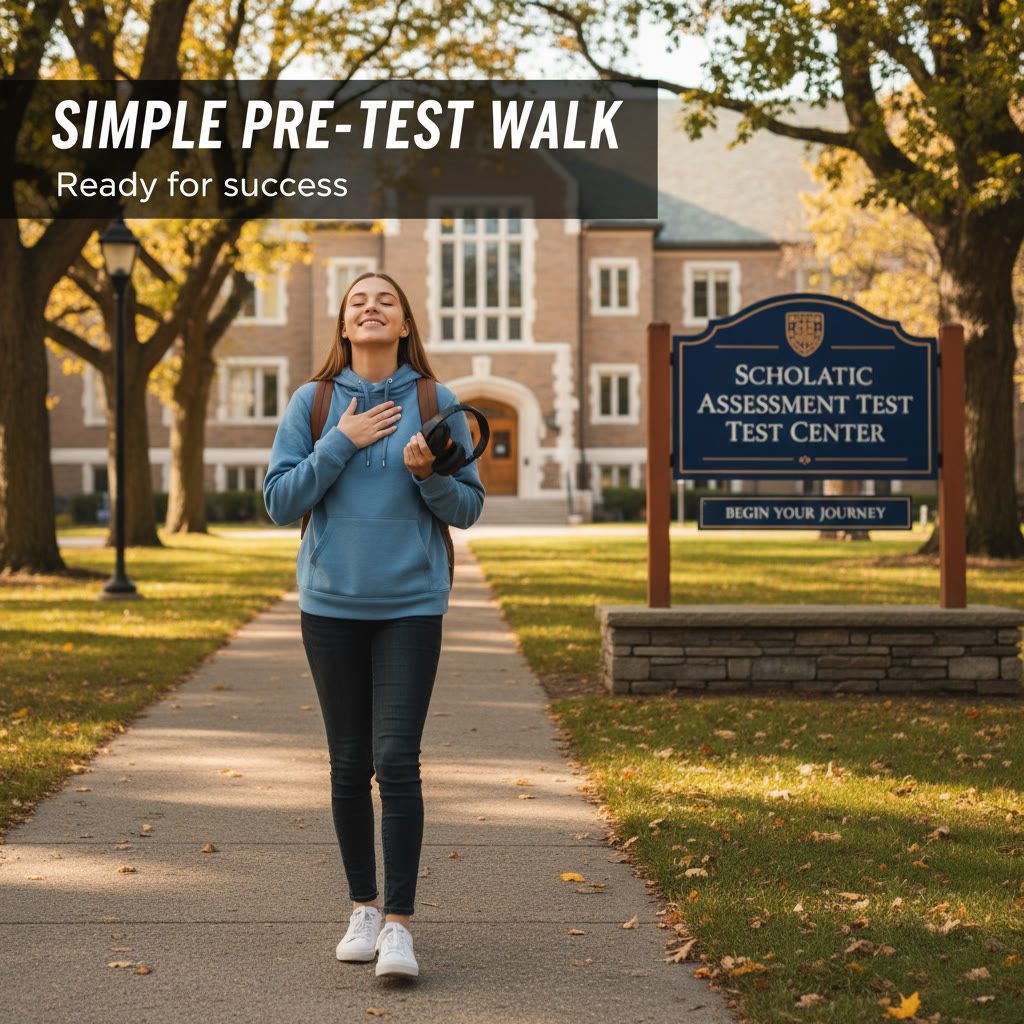Why Exercise Matters for SAT Prep
Let’s be honest: staring at practice tests for hours on end can erode even the clearest thinking. The good news? Moving your body is one of the fastest, most reliable ways to sharpen attention, strengthen working memory, and reduce test anxiety. Exercise doesn’t just create stronger muscles — it primes the brain for learning.
What science and experience tell us
Short bouts of aerobic activity increase blood flow and deliver more oxygen and nutrients to the brain. This supports executive functions like planning, focusing, and switching between tasks — exactly the skills you need to parse complex SAT questions. Regular exercise is also associated with improved sleep quality and mood, both of which help consolidate memory and keep motivation steady across a long study calendar.
How exercise helps during different phases of prep
- Short-term (same day): A brisk 10–20-minute walk or a quick HIIT set before a study session can sharpen attention for the next 30–90 minutes.
- Medium-term (weeks): Consistent, moderate exercise raises baseline energy and reduces the crash-and-burn feeling that comes from long study marathons.
- Long-term (months): Building exercise into your routine improves sleep, mood stability, and stress resilience — all crucial for peak performance on test day.
How to Use Exercise Strategically While Preparing for the SAT
Not all movement is equally useful at every moment. The trick is to match the type and timing of exercise to your study goals. Below are practical approaches you can try; mix and match to find what fits your schedule and natural rhythms.
Before a study session: quick activation
When you’re about to tackle a focused block — say, a two-hour math practice — spend 5–15 minutes on quick activation. This is a low-barrier routine that ramps up alertness without leaving you sweaty and distracted.
- Brisk walk or light jog for 5–10 minutes
- Dynamic stretching: leg swings, arm circles, hip openers
- Bodyweight circuit (one round): 10 air squats, 8 push-ups, 20-second plank
These moves increase circulation and prime the nervous system for focused work. Finish with 1–2 minutes of deep breathing to center attention.
During study blocks: use movement as a productivity tool
Long stretches of sitting are attention killers. Use active breaks strategically to sustain focus across a study session.
- Pomodoro-style: 25–50 minutes study, 5–10 minutes movement. In those short breaks, stand up, stretch, or walk around the block.
- Microbreaks: every 30–45 minutes, perform 60–90 seconds of mobility work — shoulder rolls, neck stretches, calf raises.
- Movement for memory: after studying a difficult concept, do a one-minute burst (jumping jacks, brisk stairs) to help consolidate learning.
After heavy study: recovery and consolidation
Intense mental exertion calls for gentle physical recovery. Low-intensity activities speed up recovery and reduce stress hormones, setting you up for a good night’s sleep.
- Light cardio: a 20–30 minute walk or easy bike ride.
- Yoga or stretching: 10–20 minutes focusing on breath and mobility.
- Progressive muscle relaxation: lie down and progressively release muscle tension from toes to head.
Types of Exercise That Boost Focus (and How to Use Them)
Different kinds of movement have different cognitive payoffs. Below is a practical breakdown of what to include in a SAT-focused fitness plan.
Aerobic exercise (walking, jogging, cycling)
Why it helps: Aerobic activity reliably increases heart rate and blood flow to the brain, supporting attention, processing speed, and mood. It’s a great baseline for consistent cognitive benefits.
- Recommended: 20–40 minutes, 3–5 times per week at a comfortable pace.
- Best use: morning activation, afternoon energy boost, or evening recovery if it doesn’t interfere with sleep.
High-intensity interval training (HIIT)
Why it helps: Short, intense bursts (20 seconds to 2 minutes) followed by rest stimulate alertness and are time-efficient. HIIT can produce quick post-exercise cognitive gains that are useful before a study sprint.
- Recommended: 10–20 minutes, 2–3 times per week.
- Best use: before a short, high-focus study window or to break up long afternoons of work.
Strength training
Why it helps: Strength work supports mood, sleep quality, and long-term metabolic health. Lifting or resistance training builds physical resilience, which indirectly supports cognitive stamina during long test-prep blocks.
- Recommended: 20–40 minutes, 2–4 times per week focused on full-body movements.
- Best use: schedule on days when you will do heavier practice sets so you build both mental and physical resilience.
Mobility, stretching, and yoga
Why it helps: These practices calm the nervous system and reduce tension from studying — especially useful after long sessions of sitting. Controlled breathing in yoga also trains attention.
- Recommended: 10–20 minutes daily or after long study periods.
- Best use: evening wind-down or short breaks during study blocks to reset posture and focus.
Sample Weekly Exercise Plan for SAT Students
Here’s a realistic, balanced template you can adapt. It mixes aerobic work, HIIT, strength, and mobility to keep both body and mind responsive throughout your prep.
| Day | Workout | Duration | Focus Benefit |
|---|---|---|---|
| Monday | Brisk walk + mobility routine | 30 min | Gentle activation, improves alertness |
| Tuesday | Strength training (bodyweight or gym) | 40 min | Builds resilience and mood support |
| Wednesday | HIIT (20s on/40s off), 10 rounds | 20 min | Fast focus boost before study sprints |
| Thursday | Easy bike ride + stretching | 30 min | Recovery, stress reduction |
| Friday | Mixed cardio (run or swim) | 30–40 min | End-of-week energy recharge |
| Saturday | Strength + mobility | 40 min | Full-body resilience, posture |
| Sunday | Active recovery (walk, yoga) | 20–30 min | Rest and memory consolidation |
How to personalize this plan
If you’re balancing school, extracurriculars, or a part-time job, trim or shift durations. The key is consistency — shorter, regular workouts beat intense but sporadic ones. If you work with a coach or tutor, ask them to help schedule study sessions around your most alert times. For example, Sparkl’s personalized tutoring can help integrate tailored study plans with your exercise routine so your highest-focus sessions land at ideal times.
Micro-Routines and Breaks That Actually Work
When you’re deep in problem sets or reading dense passages, micro-movements and simple breath work can reset attention faster than scrolling social media.
Two-minute reset
- Stand up, reach for the sky for 10 seconds, then fold forward and hang for 10 seconds.
- Roll shoulders back five times; open chest.
- Three deep belly breaths (inhale 4s, exhale 6s).
Five-minute mental sprint
- 30 seconds jumping jacks
- 30 seconds high knees
- 30 seconds bodyweight squats
- 1 minute walking to cool down + deep breaths
After these five minutes, return to study immediately for a renewed burst of concentration.
Pre-Test and Test-Day Movement Strategies
Test day is as much about psychology as it is about knowledge. Movement can reduce jitters, clear the mind, and give you steady energy without taxing your focus before the exam.
The morning of the test
Keep it simple and consistent with what you’ve already practiced during prep. Here’s a short routine that many students find helpful:
- 10–20 minute brisk walk or light jog
- Dynamic stretches: leg swings, torso twists
- Two minutes of box breathing (inhale 4, hold 4, exhale 4, hold 4) to calm nerves
Right before the test
If you have time in the parking lot or hallway, do 2–5 minutes of gentle movement: march in place, shake out your hands, and take a few mindful breaths. The goal is to arrive at your seat alert and calm.
Nutrition, Sleep, and Hydration: The Unsung Partners
Exercise makes a huge difference, but its benefits multiply when you attend to sleep, hydration, and food. Think of these as the scaffolding that supports the gains from movement.
Sleep
- Aim for consistent bedtimes. Deep, regular sleep cycles boost memory consolidation — the process that locks learning into long-term storage.
- If late-night studying is unavoidable, add a short, low-intensity walk the next morning to reset your circadian rhythm.
Hydration and snacks
- Drink water steadily throughout the day. Mild dehydration dulls attention.
- Before study sessions, choose snacks that combine protein and complex carbs — yogurt with fruit, a small handful of nuts with whole-grain crackers — to sustain focus without a sugar crash.
Safety, Individual Differences, and When to Get Help
Everyone’s body and brain respond differently to exercise. Listen to yours. If you have medical conditions, injuries, or chronic fatigue, consult a healthcare provider before starting a new routine.
Signs you should adjust
- Exhaustion that worsens after workouts instead of improving.
- Persistent pain during or after movement.
- Sleep disruption after late, high-intensity sessions.
Modify intensity, shift the timing of workouts, or substitute restorative activities (walking, gentle yoga) when needed.
Tracking Progress Without Obsession
Tracking can be motivating, but it’s easy to overdo. Focus on rhythm and subjective improvements — fewer foggy afternoons, steadier practice durations, and calmer test days — rather than perfect metrics.
Simple metrics to watch
- Number of focused study blocks you complete each week
- Average mood and energy scores on a simple 1–5 scale
- Quality of sleep and how refreshed you feel
If you work with a tutor or coach, share these observations so they can adjust study schedules and intensity. A service like Sparkl can combine 1-on-1 guidance and AI-driven insights to match study sessions with your most alert windows, and suggest when to insert movement for maximal benefit.
Putting It All Together: A One-Day Example
Here is a sample day that integrates movement with focused SAT study, helping you feel alert, calm, and productive.
- 7:00 AM — Wake, hydrate, 20-minute brisk walk (activation)
- 8:00 AM — Breakfast: eggs + whole grain toast and fruit
- 9:00–11:00 AM — Focused study block #1 (use Pomodoro: 50/10). Before the session, 5-minute dynamic warm-up. Midway: 5-minute mobility break.
- 11:30 AM — Strength circuit (30–35 minutes)
- 12:30 PM — Lunch and 15-minute rest
- 2:00–4:00 PM — Focused study block #2 (practice test or problem set). Afterward: 10-minute walk to consolidate learning
- 5:00 PM — Light yoga or stretching (15 minutes)
- 7:30 PM — Short review (30 minutes) then wind-down routine and consistent bedtime
Final Notes: Make Movement Your Study Ally
Exercise doesn’t have to be a separate, time-consuming chore for SAT prep. Think of movement as a study tool — like a pencil or a calculator — that helps you use your time more effectively. Small, consistent choices add up: a brisk walk before a critical practice test, a HIIT burst before a reading block, or daily mobility to keep posture and breathing in check. Over weeks and months, this approach builds better focus, less anxiety, and more reliable performance on test day.
If you want help combining study strategies with an exercise plan that fits your life, consider asking for tailored support. Personalized tutoring — for example, Sparkl s 1-on-1 guidance and tailored study plans backed by expert tutors and AI-driven insights — can help place your most demanding study sessions at the times when exercise and circadian rhythms give you the biggest edge.
One small promise
Try one change for a week: add two 10–15 minute movement breaks each day and notice how clear your thinking feels during study. If it helps, build from there. The SAT is a test of knowledge and stamina; give your brain the fuel and movement it needs to perform its best.


Good luck — and remember: move a little, focus a lot.











No Comments
Leave a comment Cancel